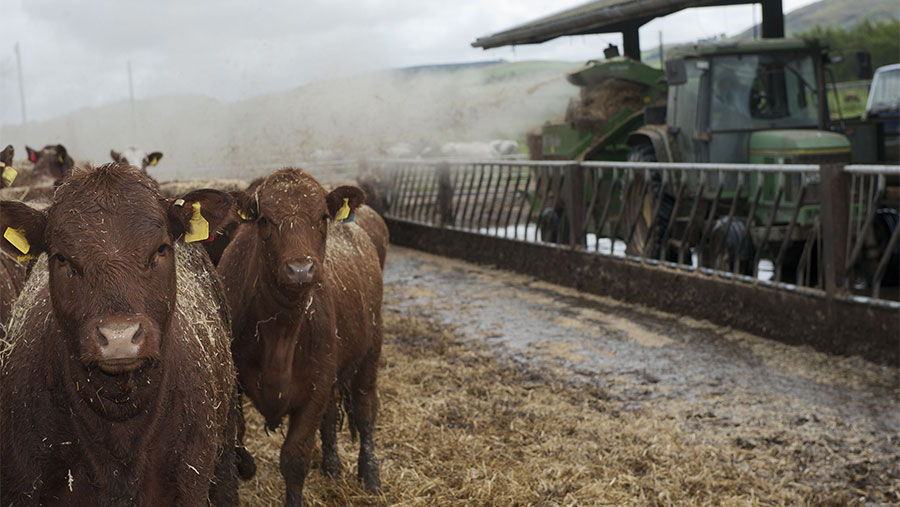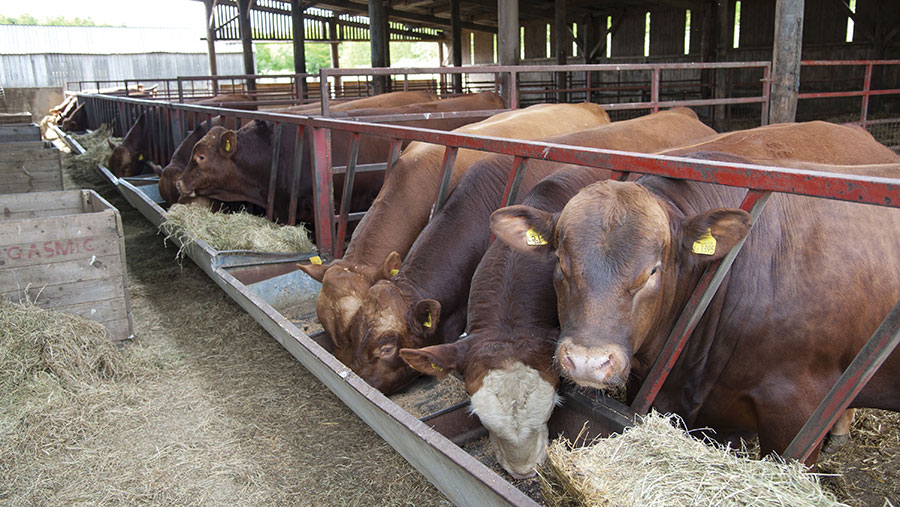Finishing cattle: A guide to health planning and quarantine
 © FLPA/Wayne Hutchinson/Shutterstock
© FLPA/Wayne Hutchinson/Shutterstock A farm-specific health plan should be in place in any cattle-finishing enterprise to help achieve good output and profitability.
This is according to veterinary surgeon Leanne Forde of Bishopton Vets, North Yorkshire, who travelled to the US to see a range of finishing enterprises in 2017.
See also: Tackling IBR – non-marker versus marker vaccines
Constantly asking questions of your system and making minor adjustments is a very important aspect of running large-scale commercial feedlots in the US Midwest, and it should be the same in the UK, she explains.
Fine margins, a relentless turnover of cattle and balancing other enterprises are common issues for cattle finishers, which is why a clear health plan is important.
Working from an animal being bought to being sold, Ms Forde details the principles of healthy finishing cattle to increase output and weight gains and reduce losses.
Sourcing
This is where it all starts. You need to get as much information as possible. The first thing to check is where they are coming from.
- Ask questions about health status, vaccinations, diet and how many holdings the animals have been on.
- When they are going through the ring or the crush, check the age against their weight. Cattle should be able to put on 0.7-1.2kg a day, depending on their breeding, gender and rearing system. If they are small for their age, this will affect your efforts. As a rule of thumb, continental-cross stores can put on more than1.4kg a day, pure dairy bulls more than 1.3kg a day and Holstein steers more than 0.8kg a day.
- Ask about their management and diet, as that will give an indication of how they are performing. It will also help you transition the cattle when they get to your farm.
- If you are in a low-risk bovine TB area and the cattle are from a high-risk area, you will have to test the cattle for TB after moving them at your own expense if they are not slaughtered within 60 days of arrival. This brings extra handling risks and stress.
- Find out if the cattle are free of bovine viral diarrhoea (BVD) or not and whether the farm is monitoring BVD. Buying in persistently infected (PI) animals has a huge effect on the overall health of a batch. Other infectious diseases such as pneumonia or lameness can be amplified if BVD is circulating.
Quarantine
This is often a bone of contention. How long should it be? This needs to be discussed on an individual farm basis. The biggest risk to health for cattle is a change in their environment, grouping and nutrition. Unfortunately, it can also be the weather, but focus on what you can control.
Settle and separate
- When cattle arrive on the farm, allow them to settle for 24-48 hours and keep them isolated.
- Do not mix them with cattle already on farm.
- Keep them in a different air space or a field with at least a 3m gap between adjoining stock.
Hydration
- Ensure cattle have plenty of clean water, as there can be a degree of dehydration after sale and transit.
- Keep the rumen healthy.
- Start cattle on a forage-only diet. Your forage will probably differ from the forage the cattle are used to, but it is safer for the rumen microbes to deal with forage than starting them with concentrate feed or grain.
- Remember that when we feed a ruminant, we are actually feeding the rumen bugs. To do that well, the rumen bugs like very gradual change. If this isn’t achieved, illnesses such as cerebrocortical necrosis (CCN), liver abscesses and acidosis can set in.
Slow diet change
- Aim to achieve a full change in diet over at least seven days. So, within a week, they can be on the farm’s growing ration.
Quarantine treatments
- After 24-48 hours, administer quarantine treatments.
- Every farm is different, but an infectious bovine rhinotracheitis (IBR) vaccination is imperative. Intranasal vaccination is the most effective. It is more difficult to administer, but it provides quicker immunity and stimulates local immunity more effectively.
- Clostridial vaccination is severely underused. Vaccines are effective and relatively cheap. Clostridial diseases are more than 95% fatal. If cattle will be on the farm longer than two months, they can complete the course. Clostridial diseases can often kill animals that are otherwise thriving and growing well, and nothing is more expensive than the death of a good beast.
Parasite control
- Parasite products must be used rationally if you are grazing your cattle as part of your system.
- The industry is seeing increasing amounts of wormer and flukicide resistance. Check with your vet what product is appropriate for your farm. For example, if you are buying in dairy-beef stores that have never been out to grass, exposure to worms and fluke will be minimal, so there’s little point in treating them.

© FLPA/Shutterstock
Tagging
Most finishers do not use BVD tag and testing when putting management tags in, but it can give peace of mind. If BVD is circulating in a batch, other disease risks are amplified.
Finishing
At this point, other than topping up feeding, minimal intervention should be needed. After quarantine, the priority is to allow the cattle to thrive and put on flesh.
Achieve the three Cs – cleanliness, consumption and consistency
- Finishing systems are hugely varied, but whatever the system, make sure animals are able to eat a consistent high-quality feed to ensure they finish well.
- Ensure animals have access to feed all the time. A lot of feed-related issues are due to animals having problems accessing feed. These can arise from empty troughs, not enough feed space (see table) or blocked hoppers.
Clean bedding
Cleanliness is vital. If bedding is clean, animals will lie down and ruminate. Dirty bedding can lead to lameness bugs thriving, which can result in animals being withdrawn when they are ready for sale, as selling lame animals is prohibited.
Get a fresh pair of eyes on the farm
Regular veterinary visits can tweak things and pre-empt issues. Monthly visits are commonplace on commercial US feedlots and can address seasonal challenges through the year. A fresh pair of eyes will see things you may have become immune to.
Recommended feed space for cattle |
||
| Liveweight | Ration fed feed barrier (mm/animal) | Ad-lib fed feed barrier (mm/animal) |
| 400 | 550 | 190 |
| 500 | 600 | 240 |
| 600 | 670 | 280 |
| 700 | 700 | 320 |
| 800 | 800 | 340 |
| Source: Farm Advisory Service, Scottish Rural Development Programme | ||
Mortality
Routine post-mortems can be very useful and be used to address issues quickly.
- Prices vary depending on the laboratory or if you are looking at a single issue, a full post-mortem or whether further tests are needed.
- Discuss post-mortem results with your vet.
- A written report can be returned in 24 hours and even if the carcass needs further testing, results are usually back in a week.
- Aim for 0% mortality, but less than 2% is a good target.
